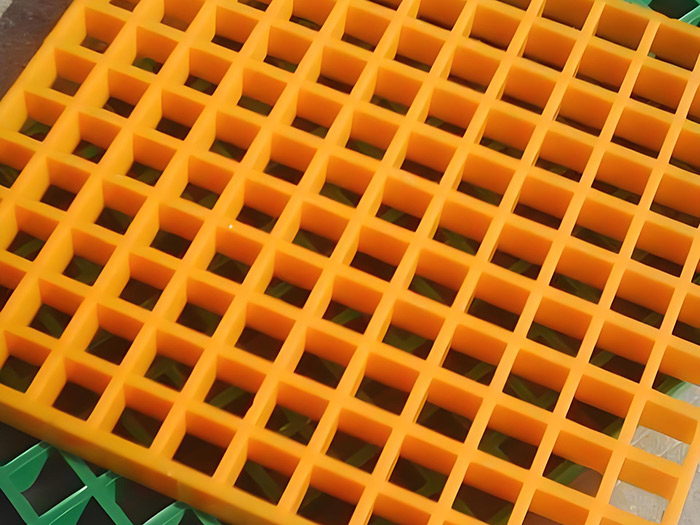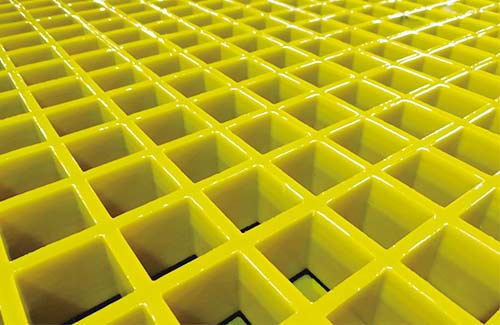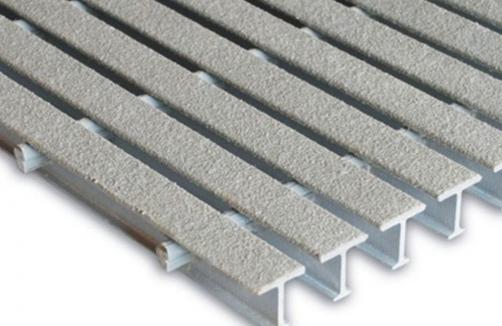مشبك FRP عالي القوة: الحل الأمثل لقوة التحمل والأداء
هل تبحث عن مادة تجمع بين القوة الاستثنائية والمتانة الفائقة لتطبيقاتك الصناعية أو التجارية؟ قد يكون صريف البوليمر المقوى بالألياف (FRP) هو الحل الذي تحتاجه. اكتسبت شبكات FRP شعبية في السنوات الأخيرة بسبب مزاياها العديدة مقارنة بالمواد التقليدية مثل الفولاذ والخشب والخرسانة. ولكن ما الذي يجعل بالضبط صريف FRP الخيار الأمثل للمتانة والأداء؟ دعنا نستكشف هذا السؤال بعمق.
ما هي شبكة FRP الشبكية؟

صريف FRP، والمعروف أيضًا باسم صريف البوليمر المقوى بالألياف، هو مادة مركبة مصنوعة من مصفوفة من راتنج البوليمر، مثل البوليستر أو إستر الفينيل، مدعمة بألياف زجاجية. ينتج عن هذا المزيج مادة خفيفة الوزن وقوية بشكل لا يصدق. على عكس المواد التقليدية، لا تصدأ أو تتآكل أو تتحلل شبكة FRP بمرور الوقت، مما يجعلها خيارًا مثاليًا للبيئات الصعبة.
لماذا تختار شبكة FRP للمتانة؟
أحد الأسباب الرئيسية لاعتبار شبكة FRP الحل الأمثل للمتانة هو مقاومتها للتآكل والهجوم الكيميائي. على عكس صريف الفولاذ، الذي يمكن أن يصدأ ويضعف بمرور الوقت عند تعرضه للرطوبة أو المواد الكيميائية، فإن صريف FRP لا يتأثر. وهذا يجعلها خيارًا ممتازًا للتطبيقات في البيئات البحرية والمصانع الكيميائية وغيرها من البيئات المسببة للتآكل.
بالإضافة إلى ذلك، تتمتع شبكة FRP بعمر افتراضي أطول مقارنةً بالمواد التقليدية. فهي لا تتطلب الطلاء أو الطلاء، مما يعني أنها تحافظ على قوتها ومظهرها لسنوات دون صيانة. وهذا لا يقلل من التكاليف على المدى الطويل فحسب، بل يضمن أيضًا أداءً ثابتًا بمرور الوقت.
فوائد أداء شبكة FRP الشبكية
وبالإضافة إلى المتانة، توفر شبكة FRP العديد من مزايا الأداء التي تجعلها متميزة. إحدى المزايا الرئيسية هي نسبة القوة إلى الوزن العالية. فالشبك المصنوع من البولي بروبيلين المقوى بالألياف الزجاجية أخف بكثير من الشبك الفولاذي، مما يسهل تركيبه ويقلل من الحمل على الهياكل الداعمة. كما أن هذه الطبيعة خفيفة الوزن تجعلها أكثر أمانًا للعمال عند المشي عليها، حيث تقلل من الإجهاد وخطر الانزلاق والسقوط.
ومن مزايا الأداء الأخرى هي خصائص الحد من الضوضاء التي تتميز بها شبكة FRP. تمتص هذه المادة الصوت بشكل أفضل من الفولاذ، مما يجعلها خيارًا مثاليًا للتطبيقات التي يكون فيها الحد من الضوضاء مهمًا، مثل المطارات أو المنشآت الصناعية. بالإضافة إلى ذلك، تتميز شبكة FRP بخصائص عزل كهربائية ممتازة، مما يجعلها مناسبة للاستخدام في العبوات الكهربائية والمحطات الفرعية.
التطبيقات الشائعة لشبكات FRP
تُستخدم شبكات FRP في مجموعة واسعة من التطبيقات في مختلف الصناعات. وتشمل بعض الاستخدامات الأكثر شيوعاً ما يلي:
- المنصات والممرات الصناعية: يوفر شبك FRP سطحًا آمنًا ومتينًا للمنصات الصناعية والممرات.
- الهياكل البحرية: مقاومته للتآكل تجعله مثاليًا للاستخدام في الأرصفة والأرصفة والمراسي.
- المصانع الكيميائية: يمكن للشبك المصنوع من البولي بروبيلين المقوى بالألياف الزجاجية أن يتحمل المواد الكيميائية القاسية دون أن يتحلل، مما يجعله مثاليًا لمصانع المعالجة الكيميائية.
- المحطات الكهربائية الفرعية: خصائصه العازلة للكهرباء تجعله مناسبًا للاستخدام في العبوات الكهربائية والمفاتيح الكهربائية.
- مصانع اللب والورق: مقاومة المادة للرطوبة والمواد الكيميائية تجعلها مثالية للاستخدام في مصانع اللب والورق.
الإجابة على الأسئلة الشائعة حول شبكة FRP الشبكية
هل شبكة FRP أغلى من المواد التقليدية؟
على الرغم من أن التكلفة الأولية لشبكات FRP قد تكون أعلى من المواد التقليدية مثل الفولاذ، إلا أن فوائدها على المدى الطويل غالباً ما تجعلها خياراً أكثر فعالية من حيث التكلفة. تتطلب شبكات FRP الحد الأدنى من الصيانة، ولها عمر خدمة أطول، ويمكن أن تقلل من تكاليف الإصلاح بمرور الوقت. بالإضافة إلى ذلك، فإن طبيعتها خفيفة الوزن يمكن أن تخفض تكاليف التركيب.
هل يمكن تخصيص مشبك FRP؟
نعم، يمكن تخصيص مشبك FRP لتلبية متطلبات المشروع المحددة. يمكن تصنيعها بأحجام وسماكات وقدرات تحميل مختلفة. هذه المرونة تجعلها مناسبة لمجموعة واسعة من التطبيقات والبيئات.
هل شبكة FRP آمنة للتطبيقات البيئية؟
بالتأكيد. تُعد شبكات FRP خيارًا صديقًا للبيئة لأنها لا تحتوي على مواد سامة ويمكن إعادة تدويرها في نهاية عمرها التشغيلي. كما أن متانتها تعني أيضاً أنها تقلل من النفايات والحاجة إلى الاستبدال المتكرر، مما يجعلها خياراً مستداماً للتطبيقات البيئية.
مشاركة فوائد شبكة FRP الشبكية
إذا كنت تعمل في مجال الإنشاءات أو الهندسة أو إدارة المرافق، فإن مشاركة فوائد شبك FRP مع زملائك وعملائك يمكن أن يؤدي إلى حلول أكثر ابتكارًا ودوامًا. فكر في مشاركة هذه المقالة أو إنشاء المحتوى الخاص بك الذي يسلط الضوء على مزايا شبكات FRP. من خلال القيام بذلك، يمكنك المساهمة في اعتماد مواد مستدامة وعالية الأداء في الصناعة.
الخاتمة
شبكة FRP عالية القوة هي بالفعل الحل الأمثل للمتانة والأداء. إن مقاومتها للتآكل، وعمر الخدمة الطويل، وفوائد الأداء العديدة تجعلها خيارًا مثاليًا لمجموعة واسعة من التطبيقات. من خلال فهم مزايا صريف FRP ومشاركة هذه المعرفة مع الآخرين، يمكننا الاستمرار في تطوير استخدام المواد المبتكرة في البناء والإعدادات الصناعية.
سواء كنت تتطلع إلى استبدال المواد التقليدية بشيء أكثر متانة أو تبحث عن مادة توفر أداءً فائقًا، فإن شبكة FRP هي مادة تستحق الدراسة. إن قدرتها على تلبية متطلبات البيئات الأكثر تحديًا مع توفير قيمة طويلة الأجل تجعلها خيارًا متميزًا لأي مشروع.







